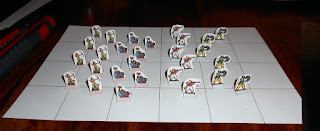Each unit is described by a stat block with attributes like "shooting skill", "power" and "courage." They may also have weapons that modify those attributes and armor that allows for armor saves. There is also a "wound chart" to determine if a hit causes damage. In these aspects the game reminds me of some other game that I would rather not reference. However, in general it seems more streamlined than what little I actually remember of that other game.
Here are the figures I used for this playtest. Border War is about humans from the Dominion trying to take down the settlements that their escaped slaves have built in the Blasted Desert. Not a particularly pretty affair but I suppose war never is, regardless of motives. Anyway, these are PERMES pirates, dwarves and elves printed at about 40% scale. I used the standard stat blocks for Garmarians (some with muskets and knives, others with swords and shields), Dwarves (with axes and shields) and Elves (with short bows and knives) from the Border War rulebook.
Having finished my first read of Featherstone's Solo Wargames, even if it was a little hasty, and given that Border War does not have its own solo system, I decided to incorporate a few ideas into my little battle. First, I split each force in smaller teams and randomized their deployment. In doing so, it was determined that one team with three Garmarian shooters would arrive only at the end of my third turn, and a team of four dwarves would arrive at the end of the enemy's second turn. This is the initial setup for the game.
The first two turns were spent maneuvering for the battle. During the third turn a group of elves attacked the Garmarian shooters to no effect. They attacked in turn, defeating two elves and causing the other two to flee. The human and dwarf warriors also engaged in combat but no one was hurt at this point. Here is a picture at the end of the third turn.
The melee and ranged combats continued during the fourth and fifth turns, while the reserves struggled to reach the battle. Eventually one dwarf and a human shooter were defeated. This is the state of the table after the fifth turn.
By the seventh and last turn, the reserve dwarves had almost entered combat and the human shooters were reaching the range of their muskets. The humans had lost six men for a total point cost of 460 and the slave rebels lost three elves and a dwarf for a point cost of 335. Therefore, the slave rebels won the match.
Conclusion
I found Border War enjoyable. The rules are simple and easy to follow. I had a few doubts but the author has quickly answered them in this post of the Cardboard Warriors forum. If I would have anything to comment is that command range for the leaders seems a little short; often I could not take advantage of the extra orders they were entitled due to this. Still, it might be a matter of positioning my leader in a better way.
The part of the Border Wars rules I did not test was the campaign system, which seems very interesting. It includes experience gain for units, which allows them to improve, as well as an upkeep system that may result in deserters and even mutiny.
The part of the Border Wars rules I did not test was the campaign system, which seems very interesting. It includes experience gain for units, which allows them to improve, as well as an upkeep system that may result in deserters and even mutiny.





No comments:
Post a Comment